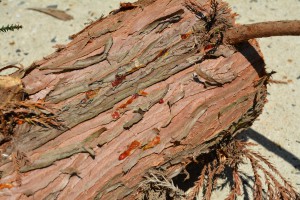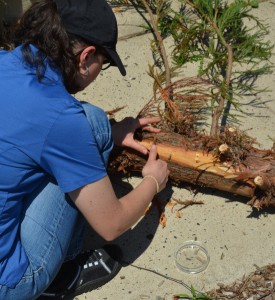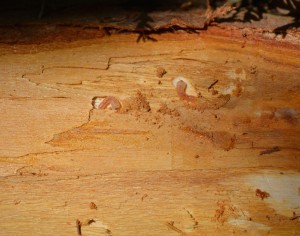Cryptomeria samples have been coming into the Plant Diagnostic Laboratory with increasing frequency this spring. Their issues with winter damage, particularly this year, have been chronicled on this blog. We’ve also had a couple of samples diagnosed with Maskell scale in the lab this spring, too. Pretty routine set of samples, just a few more than usual, until last week that is…
… when we got an apparently winter-damaged Cryptomeria that was bleeding from the bark. We initially cut into the wood expecting perhaps a fungal canker (Seiridium?), but what we found were the larvae of the Japanese cedar longhorned beetle, Callidiellum rufipenne. This beetle is an exotic insect from Asia that is known as a secondary invader of weakend trees in the Cupressaceae. There are reports that this critter will attack apparently healthy nursery stock in the northeastern United States, but until now, we have only seen them in our lab in temperature and moisture stressed or recently transplanted arborvitae samples.
Known hosts include: Japanese cedar (Cryptomeria japonica), Hinoki cypress (Chamaecyparis obtusa), Sawara cypress (Chamaecyparis pisifera), false arborvitae (Thujopsis dolabrata), firs (Abies spp.), pines (Pinus spp), eastern red cedar (Juniperus virginiana), American arborvitae (Thuja occidentalis), juniper (Juniperus communis), and Monterey cypress (Cupressus macrocarpa).
Japanese cedar longhorned beetle has a one-year life cycle. Adults emerge in the spring to mate. Females lay eggs in bark crevices, and after hatching, the larvae enter the bark to feed on the phloem tissue. Their serpentine galleries are generally frass-filled. In late summer, penultimate larvae move into the sapwood to create oval cells in which they pupate. The adults that emerge remain in the wood until spring. The breeding and feeding behavior causes branch dieback and hastens the decline of stressed trees.
A good IPM program that includes careful attention to the plant health needs of the tree, early detection, and the prompt removal of infested trees are the best controls. My friend at Westchester County Cooperative Extension in New York says he hates Cryptomeria as much as I hate boxwood. Hate is a strong term–I don’t really hate boxwood, I actually love the dead ones. And I am sure Jerry doesn’t really hate Cryptomeria either, but at the very least, with this new addition to the arsenal of problems facing Cryptomeria, they are certainly moving higher on my list of plants that I love to hate!




